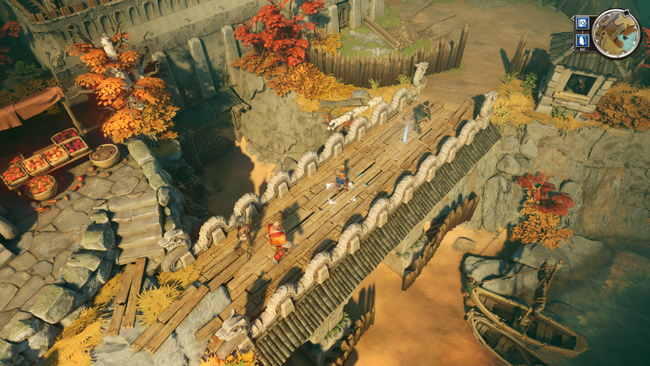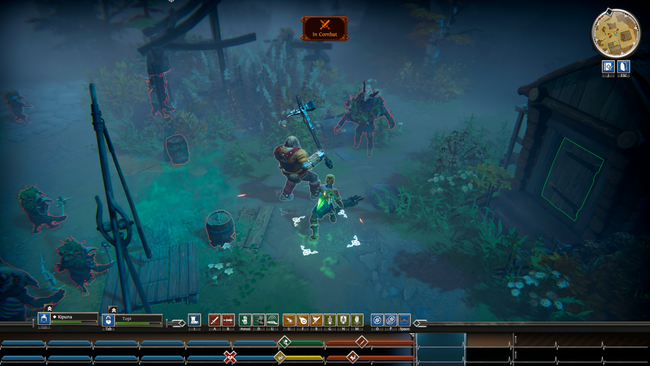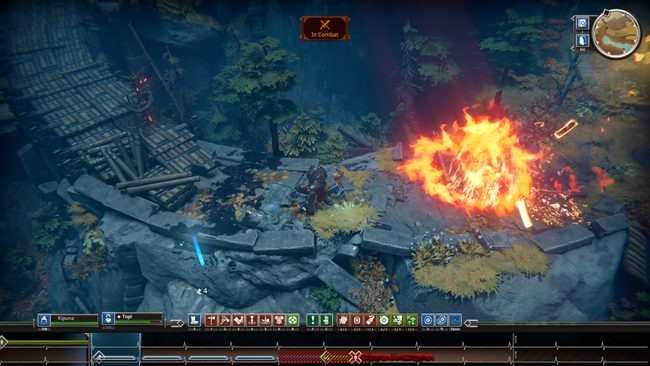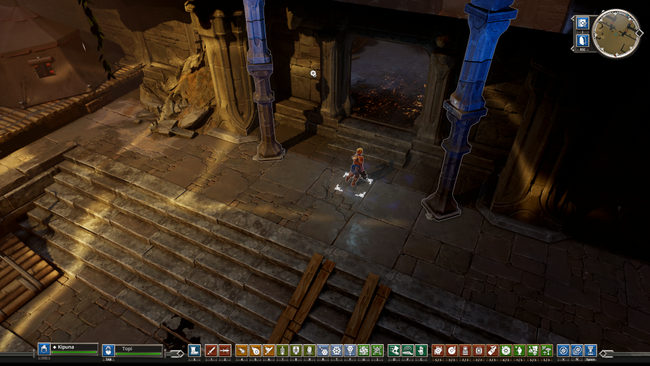Iron Danger Review
We're settling into a busy time of year for game releases, with a number of big or highly-anticipated RPGs soon releasing for fans of established developers or franchises. Iron Danger is, however, not one of those games. It is instead a debut project from a small Helsinki studio looking to make their first mark on the world with a unique take on tactical RPG stylings and combat.
Iron Danger is set in a Nordic-inspired world following the story of Kipuna, a normal village girl whose home is unexpectedly razed by Northlander invaders. During the assault, while trying to escape from the madness, Kipuna ultimately falls to her death ... or at least that how it initially seems. Thanks to divine intervention from a forgotten god, Kipuna finds herself revived with the ability to manipulate space and time. Before she even has much time to mourn the loss of her home or even get a chance to think, Kipuna is soon thrown into a larger conflict that could decide the fate of civilization.

Thanks to her newfound powers, Kipuna can not only throw fireballs to incinerate enemies, but she can now rewind time in short bursts to get the upper hand in battle: predicting enemy movements and becoming victorious in every skirmish she encounters. This dynamic time manipulation is the core of Iron Danger's tactical identity and gameplay. It is played from a classic isometric perspective where Kipuna and an allied partner take on the combatants from the North.
Iron Danger is actually not much of an RPG, mechanically speaking. Characters do not gain EXP or levels. There is no equipment to manage, money to spend, nor quests to undertake. It's really more of a pure tactics or puzzle game overall, mixing real-time action with a strategic pause system to plan around the various combat encounters you'll run into. The combat in place is legitimately a novel system that doesn't quite play like any other tactics game I've seen. Things do play out in real-time rather than turns, but you'll be pausing the action constantly to line up your motions and blocks in line with enemy movement in order to optimize your damage output and minimize damage taken. Even standard foes are quite deadly to Kipuna and her allies, where even just 2 or 3 hits can lead to your demise. So, you'll want to avoid attacks as often as possible, and manipulating time is the way to do this.
The timeline mechanic actually most closely looks like something you would see in a video editing program, but instead of lining up clips/audio/effects, you're lining up your attacks and character positioning. Each movement or action takes up slots on the timeline, each slot called a heartbeat, and learning how to modify the system is effectively how you play the game. Throughout Iron Danger, you are controlling two characters, Kipuna and a sidekick depending on where you are in the storyline. In a way, in terms of combat execution, I think it works exactly how the devs intended it to. However, conceptually, it's somewhat tedious to play.

Due to the reliance on the time-rewinding mechanic, you constantly (and I mean constantly) have to pause to peek forward in time to see the enemy action, then rewind time to avoid or block it, try an attack and see if it works, then rewind and adjust if it doesn't. You are also controlling two characters, which means you also constantly have to set up actions and positions for two characters, making sure both are in the right positions doing what you need them to. You basically want to play as a perfectionist, tactically, because you have to. Eventually, you figure out a combination of movements to deal the most damage, get in all the right positions, avoid all the attacks, and win. Instead of a standard Real Time With Pause system, it's Real Time with Pause, Peek Ahead, Rewind, Act, Pause again, more Trial & Error, Pause once more, etc. Note you can only rewind about ten movements or so, such that you can't just easily revert back to the beginning of combat if things aren't going your way.
The game the timeline system actually most reminds me of, of all things, is The Caligula Effect, a Japanese RPG by FuRyu that also involves timing up attacks and dodges on a similar sort of system. Ultimately I did not care much for that game at all, where you could often brute force your way through battles by rushing everything at quickly as possible. You absolutely cannot do that in Iron Danger, however, else you'll find the game-over screen. In a way, it feels rewarding to take the time and finally line up a perfect series of movements and attacks, but it also feels somewhat tedious by design, due to how meticulous you need to be. Luckily, this is alleviated somewhat by the game's low runtime and bespoke encounters; there are no random trash mobs or grinding in Iron Danger.
The game also uses environmental interactivity to pretty good effect. Especially considering Kipuna's fire-based abilities, there are a lot of things you can burn: wood, weeds, fuel cans, and the like. So oftentimes it's not just which moves you perform on which enemies, but also making sure battle participants are all standing in just the right spots so you can use the environment to your best advantage.
It's worthwhile to note that Iron Danger can be played entirely with a two-button mouse with relative ease, though many keyboard shortcuts and functions also exist. It does not support gamepad controllers at this time.
Outside of this combat focus, the larger game structure is a much more basic component of Iron Danger. After the game's opening, you are tasked to collect the remaining shards, each of which improves Kipuna's powers. Each chapter of the game is generally broken down into a relatively linear combat zone as you make your way to the shard temple, a puzzle-focused zone within the shard temple, and a combat-focused zone as you leave the temple on your way back to your boat. After each zone, you often get a chance to upgrade one of your characters' abilities, such as a stronger fireball or a longer-lasting buff. As far as RPG progression mechanics go, that's basically the one element Iron Danger has outside of the tactical combat.

I did run into a few annoying glitches during my playthrough, though the publisher did give me warning ahead of time that my review build was an early one and that the development team was aware of many of the lingering bugs. At one point, my sidekick character got stuck on the level geometry, which forced me to restart the section as I could no longer complete it. At another point, a boss-type enemy appeared invisible to me, which made things much tougher and more awkward, though it otherwise still functioned properly and I was able to defeat it. It's possible these sorts of things will be ironed out shortly after launch, and I hope Action Squad Studios can polish up these issues quickly.
More importantly, there are some strange design hiccups, too. In a late-game scenario, I was controlling Kipuna alone as she needed to rescue a friend from an enemy pursuit. While Kipuna was quite capable at this point in the game, going solo reduces your battle capability quite considerably, so getting into combat was a dangerous risk. Kipuna mentions to herself here that "there are plenty of places to hide", which indeed there were several patches of weeds I could work my way through. Since you don't gain EXP anyway, I figured I'd sneak my way to the rescuee, and then sneak my way out - that seemed to be what the game wanted me to do. I successfully made it to the rescuee without too much trouble, but on the way back, I ran into what I believe is an unavoidable boss encounter, which essentially alerted the dozen-or-so enemies around me, resulting in a battle stacked against me.
I ultimately decided to re-do the section without sneaking, instead slowly but carefully picking off the enemies one-by-one as I performed the rescue, which made the incoming boss battle much, much more doable -- there were no longer a dozen newly alerted guards around when the boss battle inevitably began. Perhaps that's what the game wanted me to do in the first place. But I felt like I was being punished for trying another tactic that was proper and appropriate given the plot circumstances and the game mechanics up to that point.

Iron Danger is a game focused on its novel time-rewinding combat system first and foremost, for better or worse. The storyline is a fine premise to work off of, but it's not the main draw to the game. The task being to collect six different shards means the story beats are generally cyclical each chapter, and the Northlander foes are pretty much treated like a blanket evil villain without too much depth to their motivations. For what it's worth, the English voice acting is competent, better than I expected for a game of this scope.
The ending to the game actually caught me off guard a bit. While I could tell I was approaching the conclusion to the storyline, the game credits appeared suddenly before I expected them to, as I audibly blurted out 'wait, that's it?' to my computer screen. It's not quite a cliffhanger ending, but it felt premature as if the developers clearly want the story to continue in another game or piece of media, leaving an unsatisfying ending here. A few looming threats are mentioned in a handful of places throughout the game, but they are never quite explored in Iron Danger.
Iron Danger is a unique tactical game unlike most others out there. Clocking in at around 12 hours long, it doesn't overstay its welcome. It's an interesting take on a tactical style, but I don't think it will leave a lasting impression on me.